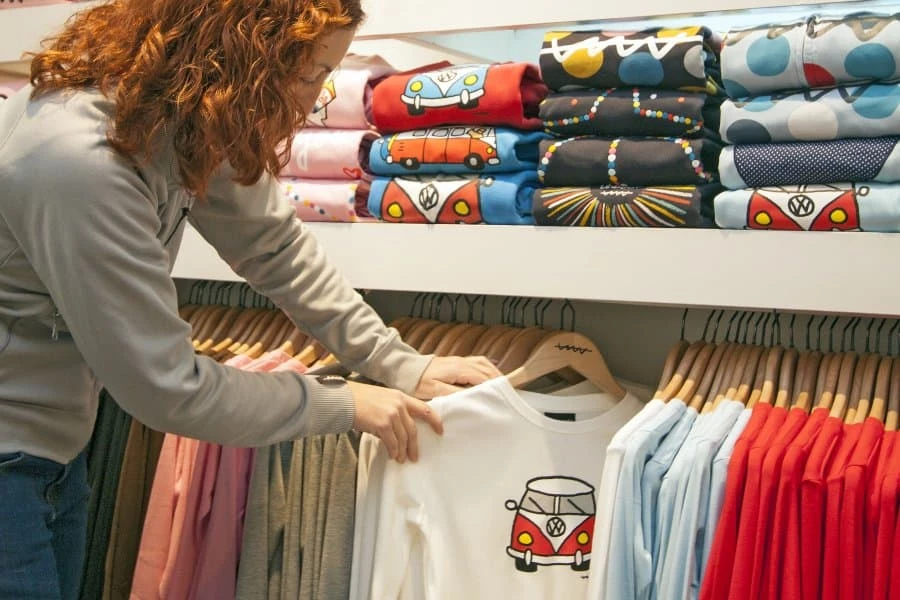Today there’s more choice of clothing than ever. Whatever you want or need is available at any mall or online; all you need to do is pay!
But the ever-growing options bring their own challenges even when shopping for humble tees.
Yes, you can find multiple colours and styles, but how long will these t-shirts last and will you need to buy a new selection after only a couple of washes?
If you know the primary quality standards in T-shirts and what to check before buying, the answer is no. Get that right, and you’ll wear your tees for a long, long time!
T-Shirt Quality Checklist
To make the whole t-shirt buying process easy for you, we’ve created a simple t-shirt quality checklist that will come in handy wherever you’re looking for a new piece.
#1 Check the fabric
It’s an obvious one, but many people don’t spend enough time inspecting the t-shirt fabric, especially if the label says “100% cotton”. But remember that even such a tee can be of low quality and lose its shape after you wear it for a couple of weeks.
So once you pick up the garment, take note of how it feels: is it soft, silky or rough and even itchy? High-quality cotton or cotton blend will always be smooth and very pleasant to touch.
The second step is noticing the thickness of the tee. Yes, if you’re shopping for a summer tee, you don’t want it to be too thick, it shouldn’t be see-through either.
When the fabric is very thin, the t-shirt looks like a rag and doesn’t hold its shape.
#2 Check the colour
It’s pretty uncommon to find a patchy t-shirt these days, but it happens, so inspect it from all sides.
If there are run-off lines or discolouration, it means the brand’s fabric dye budget was low, and the result is not only unpleasant to look at but also could cause skin irritations and allergies.
#3 Check the seams and stitching
If the t-shirt you’re looking at has passed the fabric quality test, move on to the seams and stitches.
You clearly shouldn’t see any loose stitching, the seams should be aligned and don’t pull the tee to all sides, and the fabric shouldn’t gather at the seams.
Check the shoulders, the collar and the sides – it will take less than a minute, but they will tell you everything you know. Make sure there are no skipped stitches or double seams.
Lastly, pay attention to the bottom of the shirt – often, it has poorly covered edges that start fraying in a week or so of wear.
Why so many possible defects? Many brands try to save costs on new machinery or their workers hence the poor results.
#4 Check the fit
Some of those defects are visible to the naked eye, but others will become apparent only after trying the garment on. The pulling in the armpits? Yes, it’s a sign of low-quality production.
Once you put on the t-shirt, you will notice if it looks good on you overall, but also pay closer attention to the shoulders and sides. They should fall straight and not droop or look like they’re pulling to any side.
Finally, make sure that the shirt really fits you and brings out the best of your body type. For some guys, it’s a more fitted t-shirt, and some look much better in an oversized one.
Stay away from extremes, though, as super-tight tees look like you’re trying too hard, and too large t-shirts make you look like you’re wearing something from your dads closet!
If you prefer shopping online, save yourself a potential headache and get your tees from trusted brands such as the fitted t-shirts from Fresh Clean Tees that guarantee quality and great fit!
Other Things You Should Consinder
Besides this essential quality standard checklist, you should also remember a few general guidelines for purchasing a high-quality and ethically made t-shirt.
Don’t get seduced by marketing
While many famous brands might provide a higher quality garment, many spend more money on marketing than ensuring the quality of the tee.
That’s why don’t just trust the company name, but always look for other proof of quality (see the checklist above).
One of the most critical roles of marketing is to convince you that you need specifically their tee to look good and that spending an exorbitant amount of money just for the label is completely normal. $200 for a white t-shirt? We’re not convinced!
Some might argue that it’s a personal preference and that certain brands will make you feel better and more confident, but we say – don’t fall for the trick!
Especially since today, there are so many amazing, cool and unique brands that provide the same hip factor for affordable prices and high- quality.
Don’t be TOO cheap
The other end of the spectrum is buying only super cheap t-shirts (we’re talking $5 per piece) and still expecting high quality.
While anomalies can happen, generally, if something is too good to be true, it is! Even if you could buy fabric for that price, think about the labour costs. Do you really want to support sweatshops in developing countries? We didn’t think so!
Again, as per our previous point, you don’t need to spend hundreds of dollars on famous brands; find the perfect middle where you’re not participating in unethical labour practices and also aren’t breaking the bank!
What Does The Label Say?
Not everyone checks the labels while shopping, especially for t-shirts. But you should because the label shows you how to take care of the garment and what it’s made of.
If the label doesn’t exist, is very vague about the shirt’s origins or doesn’t have any care (washing, drying, ironing) instructions, there’s your legitimate sign that’s something’s off.
It’s very likely that your t-shirt will fall to pieces after one or two washes and that it’s been made using unethical labour practices.
Sometimes small and very new brands might omit labels due to inexperience. If you suspect that’s the case and like the tee, email them or ask the store attendant for more information.







